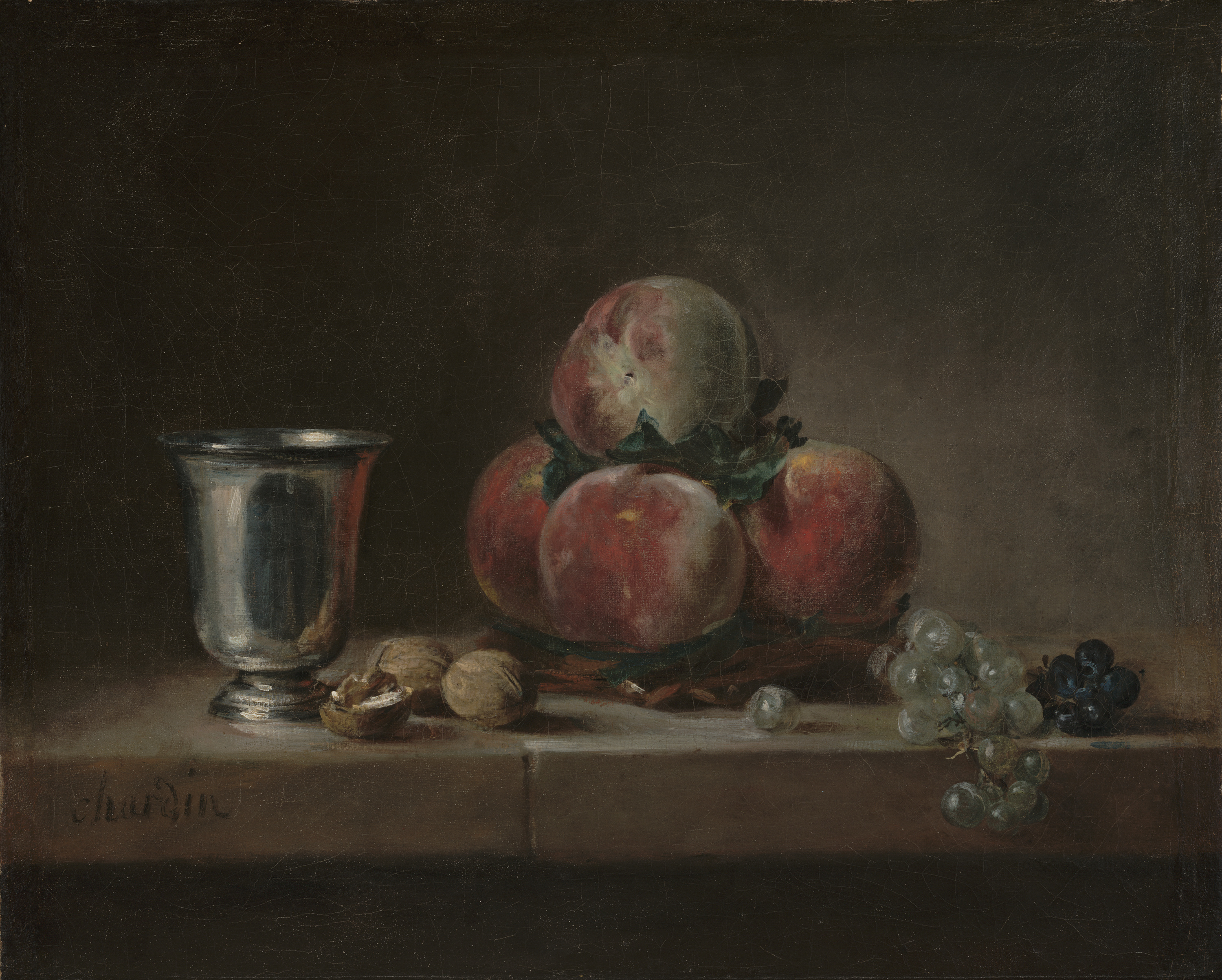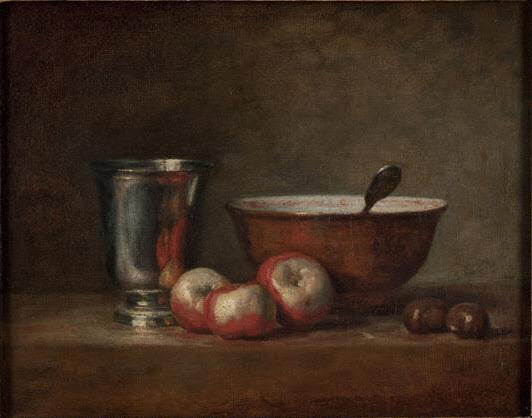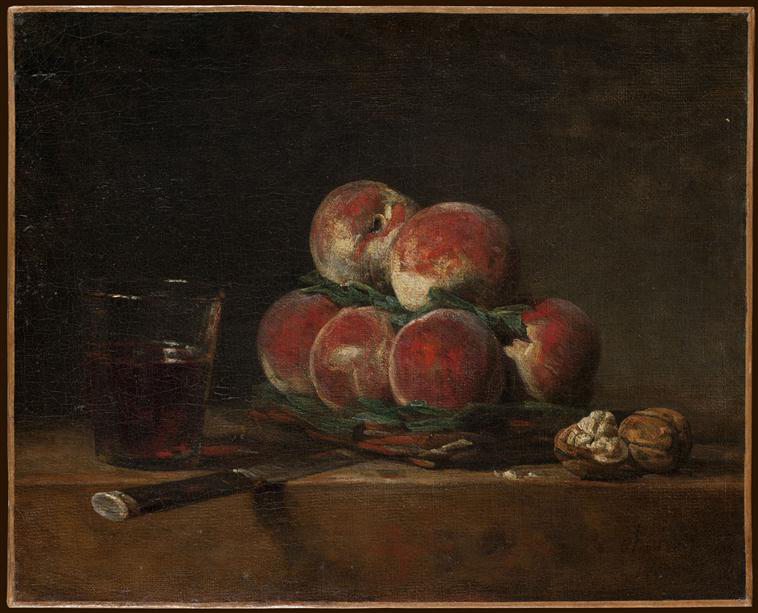
Still Life with Peaches, a Silver Goblet, Grapes, and Walnuts
| Artist | Jean-Siméon Chardin (French, 1699–1779) |
| Date | about 1759–1760 |
| Medium | Oil on canvas |
| Dimensions | 38.1 × 46.7 cm (15 × 18 3⁄8 in.) |
| Accession Number | 86.PA.544 |
Of Jean-Siméon Chardin’s submissions to the 1763 Salon, the great critic and philosophe Denis Diderot (1713–1784) wrote, “This is nature itself; these objects, whose truthfulness tricks the eye, exist outside the canvas … Oh, Chardin! On your palette you grind not white, red, and black but the substance itself of things; you take light and air on the tip of your brush and fix them to the canvas.”1 Among the paintings so rapturously described might have been this still life, whose spellbound naturalism endows its painted objects with an almost magical presence.
Four peaches sit in a shallow basket, their velvet flesh protected by a nest of leaves, dark green and papery in texture. At left, a silver goblet catches the peaches’ reflection along its edge and mirrors three walnuts resting at its foot. One of these has been cracked open, with bright pith and meat exposed, but the others remain tightly sealed, casting gold-tinged pools of shadow on the slab where the objects are arrayed. Two bunches of grapes appear at right, one bearing dusky purple fruit; the other, spilling over the ledge, pale and gleaming green. A single grape has rolled away from this cluster and rests like a pearl near the center of the composition. Bright impasto along the goblet’s beveled lip and foot and on the taut surfaces of the grapes suggests a light source outside the picture, to the left. Yet the composition also seems somehow lit from within by its blushing peaches and translucent grapes.
Chardin was born into a Parisian artisanal family in 1699. He received his training from the history painters Pierre Jacques Cazes (1676–1754) and Noël Nicolas Coypel (1690–1734). Realizing that his particular gifts (as well as his lack of a liberal education) better suited him to the observational genres than to more literary subjects, Chardin quickly abandoned his masters’ manner, although he retained a reverence for the Académie Royale de Peinture et de Sculpture, of which both were members. As a specialist in the so-called minor genres—a painter, as the Academy classified him, “skilled in animals and fruits”—Chardin could never aspire to the professional attainments of such illustrious contemporaries as François Boucher or Carle van Loo. Nonetheless, he secured for himself a successful official career, serving for twenty years as the Academy’s treasurer, receiving a royal pension, and ultimately obtaining lodgings in the Palais du Louvre. From 1755, Chardin acted as tapissier at the Academy’s biennial Salons, overseeing the arrangement of paintings displayed, among them, many of his own.2
Peaches, a favorite subject for Chardin, appear in roughly ten percent of his compositions,3 and opinions differ as to which surviving paintings correspond to those listed in the Salon livrets. The present work may have figured among Chardin’s submissions to the Salon of 1763, the group hailed by Diderot as painted with light and air. In 1933, Georges Wildenstein identified the Getty picture as that lent to the exhibition by Jean-Baptiste Lemoyne II (1704–1778) on the basis of the 1763 Salon livret and a 1778 sale catalogue.4 In 1983, Pierre Rosenberg challenged this identification, pointing to the painting’s signature (“Chardin” rather than “Chardin 1761”—the inscription listed in an 1828 catalogue of the Lemoyne collection5) and to its dimensions, which seemed to be closer to those of another still life that appeared in a 1786 sale of the Aubert collection.6

Following its acquisition by the Getty in 1986, however, the painting underwent treatment that recovered 1.5 cm of height and 1.4 cm of width from folded edges, restoring the composition to its original dimensions of 38.1 x 46.7 cm.7 These correspond more closely to the 14 x 17 “pouces” (i.e., 37.8 x 45.9 cm) of the Lemoyne picture than to the 13 x 16 (i.e., 35.2 x 43.4 cm) of the Aubert painting. The folding likely occurred in the mid-nineteenth century (after the Lemoyne sales of 1778 and 1828), when the painting was fitted to a new stretcher.8 Hence, although the question of the inscription remains, the Getty painting may yet prove to be the same that enchanted Diderot at the Salon of 1763.
The picture’s style certainly places it in the phase of Chardin’s career around 1760, near the end of his second still-life period. His still lifes dating from before 1733 emphasize contingency and irregularity, employing rich impasto to render varied surface textures and arranging objects in asymmetrical, unstable compositions. By contrast, the works he painted upon his return to the genre after 1748, having devoted fifteen years to figural compositions, are characterized by a sense of unity—permanence even—with smoother brushwork imparting a more uniform appearance to his surfaces, and tighter, more stable groupings of objects convincingly enveloped in air and space.9
By comparing how the silver goblet is rendered in the present picture with its treatment in a pre-1728 composition at the Louvre (fig. 1), one readily observes the artist’s change of approach. The goblet, apparently one of a pair, was stolen from the artist’s lodgings at the Louvre by an unemployed servant in 1759 but recovered by the police;10 it figures in several inventories of the artist’s possessions and recurs in still lifes throughout his career.11 Whereas the Louvre painting represents the vessel with brittle precision, emphasizing its hard, metallic sheen through a series of long, slender impasted strokes, the Getty picture evokes the goblet’s volume and weight, reserving the use of thicker pigment for the lip and foot. The Louvre cup glistens; its hard, slick surface contrasts with the soft fruit beside it. The Getty goblet glows; its subtle highlights and rondeurs echo those of the neighboring peaches and grapes.
The Louvre picture, more imposing in size and more ambitious in composition, bears the stamp of Chardin’s predecessors, the early-eighteenth-century still-life masters Alexandre-François Desportes (1661–1743) and Jean-Baptiste Oudry (1686–1755), known for the lavish splendor of their dessert tables and hunting trophies. Although eschewing the grandeur of such subject matter, Chardin’s early picture nonetheless emulates Desportes’s and Oudry’s work in the heterogeneity of objects and textures represented and in the asymmetry of its composition. The Getty painting, by contrast, anticipates the gravity, geometry, and quiet monumentality of such late still lifes as the Basket of Wild Strawberries, Apples, Chestnuts, Bowl, and Silver Goblet (fig. 2), and Basket of Peaches with Walnuts, Knife, and Glass of Wine (fig. 3). With the first, the Getty Peaches shares a pyramidal composition offset by a gleaming vessel; with the second, its creamy rendering of the goblet; with the last, its downy, glowing fruit. Painstakingly selected and placed, the contents of these pictures are neither so prosaic as the copper pots and gutted fish of the artist’s early kitchen arrangements nor so elegant as the preserved fruit and faïences of his more expansive dessert tables. Taking their cues from the seventeenth-century Dutch still lifes of Pieter Claesz. (1597–1660) and Willem Kalf (1619–1693),12 these small-scale pictures simultaneously document and induce an intensely private experience of rapt looking.
- Emily A. Beeny
September 2012
- Diderot, “Salon de 1763” (1763) in Denis Diderot: Salons de 1759, 1761, 1763, Jean Seznec, ed. (Paris: Arts et Métiers Graphiques/Flammarion, 1967), pp. 138–39: “C’est la nature même; les objets sont hors de la toile et d’une vérité à tromper les yeux … O Chardin! Ce n’est pas du blanc, du rouge, du noir que tu broies sur ta palette; c’est la substance même des objets, c’est l’air et la lumière que tu prends à la pointe de ton pinceau et que tu attaches sur la toile.” ↩
- On Chardin as tapissier, see Dorit Hempelmann, “Maître-Peintre, Conseiller, Trésorier, Tapissier—Chardin und die Académie,” in Jean-Siméon Chardin, 1699–1779: Werk, Herkunft, Wirkung, exh. cat. (Karlsruhe: Staatliche Kunsthalle, 1999), pp. 31–39; Ryan White, “Vision, Display, and Information: Chardin as Tapissier.” (Paper delivered at the College Art Association Annual Conference, February 11, 2010). ↩
- At least 22 of the 201 compositions included in Pierre Rosenberg’s catalogue raisonné. See Tout l’oeuvre peint de Chardin (Paris: Flammarion, 1983), pp. 69–114. ↩
- Chardin’s painting of peaches at the Salon of 1763 was exhibited under no. 62. See the Explication des peintures, sculptures, et gravures de messieurs de l’Académie Royale, dont l’exposition a été ordonnée, suivant l’intention de Sa Majesté, par M. le Marquis de Marigny [ … ] dans le grand Salon du Louvre, pour l’année 1763 (Paris: Jean-Thomas Herissant, 1763), p. 15: “Autre petit Tableau, appartenant à M. Lemoyne, Sculpteur du Roi.” The same picture was unsuccessfully put up for sale in 1778. See Le Brun, Paris. Catalogue de différens tableaux originaux des trois écoles [ … ] provenans du cabinet du feu M. Lemoyne. August 10, 1778, p. 13, no. 26: “Un tableau d’une bonne couleur & d’une touché hardie, représentant une table de pierre sur laquelle sont poses un panier de pêches, deux grappes de raisin, un goblet, & deux noix. Hauteur 14 pouc. Larger 16 pouces. T.” See Wildenstein, Chardin (Paris: Les Beaux-Arts, 1933), p. 215, no. 793. ↩
- The sale took place upon the death of Jean-Baptiste Lemoyne II’s son, Pierre-Hippolyte Lemoyne (1748–1828). Duchesne, Paris. Catalogue de tableaux, dessins, estampes, livres d’architecture et objets de curiosité du cabinet de feu Pierre-Hippolyte Lemoyne, architecte. May 19, 1828, p. 16, lot 62: “Un Déjeûner avec des pêches, du raisin, etc.: sur la table à gauche, Chardin, 1761. Larg. 17 p., haut 14 p.” ↩
- See Rosenberg 1983 (note 3), p. 106, no. 153. The Aubert sale catalogue: Paillet, Paris. Catalogue des tableaux précieux, dessins, gouaches, estampes, portraits en email [ … ] & autres objets curieux qui composoient le cabinet du feu M. Aubert, jouaillier de la couronne. March 2, 1786, p. 29, lot. 56: “Un autre Tableau, bien étudié & d’une belle couleur, représentant un panier de pêches, du raisin, des noix, & un gobelet d’argent, poses sur une table. Hauteur 13 pouces, largeur 16. T.” ↩
- See Mark Leonard, “Treatment of an Unlined Chardin Still Life,” in American Institute for Conservation of Historic and Artistic Works: Preprints of Papers Presented at the Fifteenth Annual Meeting, Vancouver, British Columbia, Canada, May 20–24, 1987 (Washington, DC: AIC, 1987), pp. 211–12. ↩
- Condition report (February 18, 1986), The J. Paul Getty Museum Paintings Conservation file. ↩
- Pierre Rosenberg and Renaud Temperini have provided a succinct description of this shift in Chardin (Paris: Flammarion, 1999), pp. 123–24. Philip Conisbee correlated Chardin’s change in style and sensibility to the emergence of a classicizing taste among Parisian collectors in the 1750s. See Consibee, Chardin (Oxford: Phaidon, 1985). ↩
- The thief’s name (François Renaud), age (56), and condition in life come down to us through penal records (Bibliothèque de l’Arsenal, Archives de la Bastille, carton 12051, pp. 92–102). See Pierre Rosenberg and Renaud Temperini 1999 (note 9), p. 119. ↩
- The first of the inventories (Archives Nationales, Minutier Central, Étude CXVII, liasse 417) dates from November 18, 1737, and was made after the death of Chardin’s first wife. It describes “Deux gobelets aussi à pied … le tout d’argent blanc.” The other inventories, taken after the artist’s death and that of his second wife, on December 18, 1779 (A.N., Minutier Central, Étude LVI, liasse 246) and June 6, 1791 (A.N., Minutier Central, Étude XCIX, liasse 730), include similar entries. See Rosenberg, “De quelques objets chez Chardin,” in Chardin, 1699–1779, exh. cat. (Paris: Réunion des musées nationaux, 1979), pp. 67–71. ↩
- On the relationship between Chardin’s still lifes and seventeenth-century Dutch painting, see Dietmar Lüdke, “Chardin und die niederländische Malerei des 17. Jahrhunderts Dargestellt an sieben Stilleben,” in Jean-Siméon Chardin, 1699–1779: Werk, Herkunft, Wirkung 1999 (note 2), pp. 41–56. As various recent studies have indicated, eighteenth-century Parisian collectors’ taste for seventeenth-century Dutch pictures exerted a powerful influence over contemporary artistic production. See, for example, essays by Antoine Schnapper and Jacques Foucart in Au temps de Watteau, Fragonard et Chardin: Les Pays-Bas et les peintres français du XVIIIe siècle, exh. cat. (Lille: Musée des Beaux-Arts, 1985); and by Colin Bailey, Thomas W. Gaehtgens, and Barbara Gaehtgens in The Age of Watteau, Chardin, and Fragonard: Masterpieces of Genre Painting, exh. cat. (Ottawa: National Gallery of Canada, 2003). ↩

